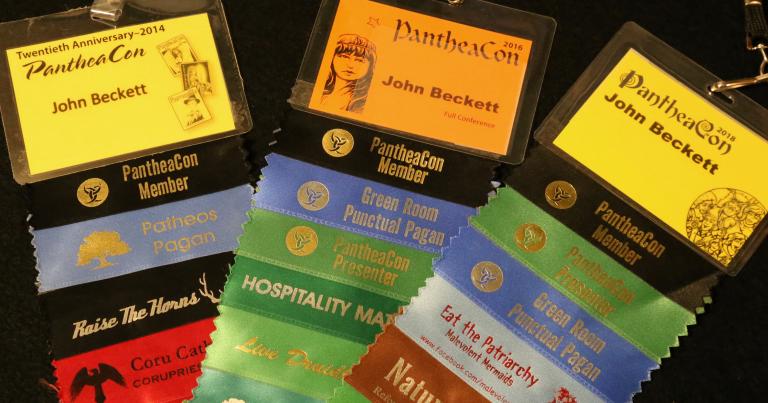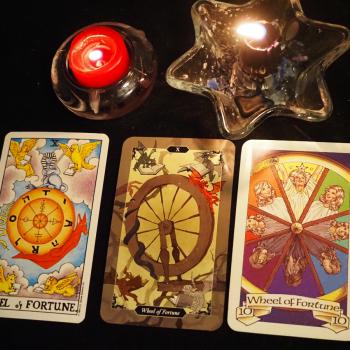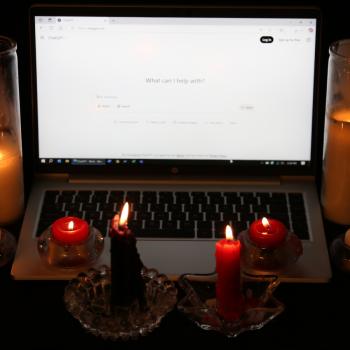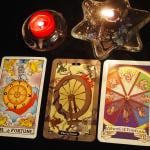Last week Pantheacon founder Glenn Turner announced that she is retiring and that the 2020 Pantheacon – the 26th edition of the largest indoor Pagan gathering in the world – will be the last.
I don’t remember when I first heard about Pantheacon. The earliest mention of it on this blog is from 2011. All I knew was that it was a big gathering in California where all the cool and important Pagans got together and talked and did ritual and partied – or so it seemed. I wanted to be there so badly that in 2013 I wrote a post titled Pantheacon Envy.
I finally went in 2014 and I had a great time – I wrote a rather long recap about it once I got home. I went again two years later and this time I was on the program – I felt like one of the cool kids! As a first-time presenter I got a small room and an early time slot, but it was packed and it seemed to be well-received. The rest of the convention went well, mostly.
I made one more trip in 2018. By that time Pantheacon was in decline, down to 1800 people from about 2500 my first year. Some of the people I most wanted to see weren’t there, and my workshop wasn’t well attended (being in the same time slot as Kristoffer Hughes and Christopher Penczak will do that).
Pantheacon is an expensive trip, they don’t compensate their presenters at all (except for those they do), and there were other places I wanted to spend my limited vacation time and travel budget. I didn’t go this year and I have no plans to go in 2020. I thought I might go again in four or five or ten years, but now I won’t.
I have a lot of thoughts about Pantheacon, but I’m going to save them for another time. This seems like the end of an era, or at least a major milestone of such an end. That makes this a good time to look ahead toward the next era – whatever that ends up becoming.
Pantheacon was never “our annual meeting”
I wasn’t there for the first Pantheacon in 1994. My understanding is that it was intended to be a local thing, but because of the Bay Area’s prominence in the Pagan movement it quickly grew into something much larger. By the time I started hearing about it someone called it “the annual meeting of the Pagan world.”
Of course, it was never anything of the sort. There are around a million people in the Big Tent of Paganism in the US alone – at most one fourth of one percent of them attended Pantheacon in any year. And that ignores all the Pagans in the rest of the world, even though some people came from Britain and Ireland and other far-off places.
Still, as my Pantheacon envy showed, many of us had the idea that Pantheacon was a big deal where big things happened. And while some big things definitely happened there, it was never the Pagan Council of Nicaea some people made it out to be.
So, what’s going to replace Pantheacon as the #1 convention for Pagans in the United States? Nothing. Because as good as Pantheacon was (and at its best it was really good) it was never as important as it was billed to be.
There are lots of good Pagan gatherings
I’ve never been to ConVocation in Detroit or Paganicon in Minneapolis, but I’ve been told they’re similar to Pantheacon, only not as crowded. I was a special guest at Sacred Space in Maryland this year – it’s excellent. And then there’s Mystic South, which is only three years old but already well established as a first class event.
Plus many, many others. I’ve been going to the ADF Texas Imbolc Retreat for six years now. Jason Mankey goes to more Pagan gatherings than anybody. He wrote this back in the summer about some of his experiences and observations. If you want to go to a Pagan convention, you have far more options than just Pantheacon, and there’s probably something within driving distance for you.
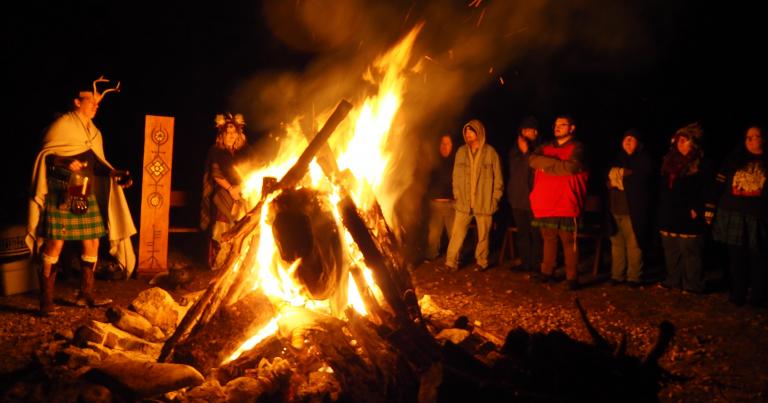
Conventions are no substitute for local communities
Particularly at well-established conventions, I sometimes hear folks say “it’s like family here.” They mean it as a good thing, but it really isn’t.
For one thing, when a convention starts to get a “family” atmosphere to it, it gets hard for newcomers feel welcome. Everyone’s so busy catching up with the friends they haven’t seen in a year that they ignore the people they don’t know.
Online friendships can be real friendships, and getting to see your online friends even one weekend a year is a good thing. But your online friends can’t be there to celebrate the high days and holy days with you eight times a year (or however often your tradition celebrates). They can’t join you for dinner every month. They can’t drive you to a doctor’s appointment or check up on your cat while you’re on vacation.
Paganism aside, this will become even more important as the Long Descent continues. During recent power outages, the city of Berkeley told residents with electricity-dependent medical needs to “use your own resources to relocate to an unaffected area.” None of us are going to get through this on our own – we need each other.
Conventions will always cost too much
Camping festivals exclude those who aren’t physically able to deal with living in a tent for a few days. Hotel-based conventions exclude those who can’t afford a long weekend’s worth of hotel rooms and restaurant meals. Either can involve air fare, or a lot of gas plus wear and tear on your car. I travel a lot, relatively speaking, but those Pantheacon trips were expensive.

Cost is no reason to discontinue Pagan conventions. It’s plenty of reason to make it clear that while they’re one part of the wider Pagan community, they’re not an essential part.
There are over 200,000 Unitarian Universalists in the United States. Perhaps 5000 attend General Assembly (which is the annual meeting of the UUA) each year. The other 195,000 simply attend Sunday services and participate in the activities of their congregations. General Assembly is important, but it’s not what makes Unitarian Universalism the good religion it is.
Pagans can learn something from UUs here.
Conventions facilitate in-person networking
For all of social media’s ills, it does a good job of helping us connect to others like ourselves. But Facebook is no substitute for talking live to someone over a cup of tea or a glass of wine. Hopefully you have a local community where you can do this. But even if you’re an active member of a Pagan group, there’s probably something that you’re really passionate about that the other members of your group aren’t. Perhaps there’s an area where you’re getting close to going off the map and you want to talk to someone who’s a bit farther along than you are.
At this year’s Mystic South, the topic du jour was Tower Time. People grabbed me to talk about what’s going on. I grabbed a few people myself. There may or may not have been a really deep conversation over a couple bottles of whiskey in my room. And speaking of whiskey, there was a wonderful conversation on the Waters of Life in Jason and Ari Mankey’s room, complete with samples.
These conversations are great. The relationships they begin and continue are even better, and they last far longer.
Conventions facilitate sharing best practices
The era of the Big Name Pagan is over. It’s been replaced by the era of the practitioner-leader. These are the people who are doing the work, then writing about it on blogs and in books, and presenting it at conventions and gatherings.
At Mystic South 2018 and at Sacred Space 2019 I co-led a devotional ritual to the Morrigan. It was a fairly simple ritual, but it was clear most of the participants had never seen anything quite like it. And now they have, and they can go back to their covens and groves and do their own. I did much the same after participating in the main ritual at the 2012 Between the Worlds.
If you’re able to go to a Pagan convention, by all means enjoy yourself. But make sure you bring back something to share with your local Pagans who weren’t able to be there.
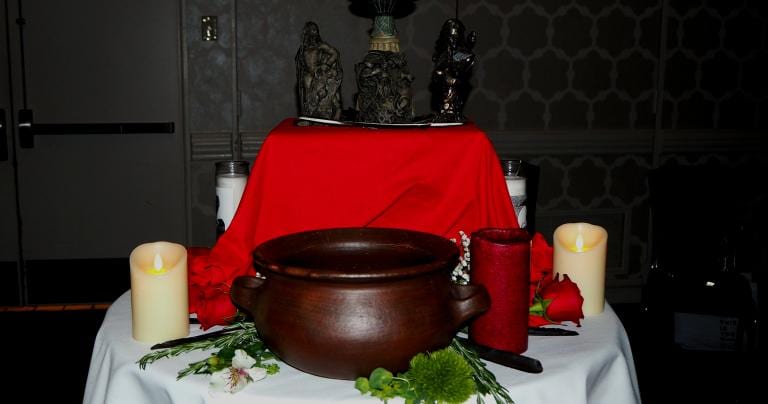
The future is decentralized
I’ve long used Pantheacon as an example of what can happen when Wiccans and Druids and Heathens and everyone else work together toward a common goal. Now, that idea looks rather naïve… though more from the various controversies than from the announcement of its end.
I hope we can still come together, if not to build a unified community then where we have common cause.
The end of Pantheacon is the end of an era in the modern Pagan movement. Or perhaps, it’s the official notice that an era ended some years ago. The future of Pagan conventions is more, smaller, local and regional gatherings.
And that’s a good thing.


